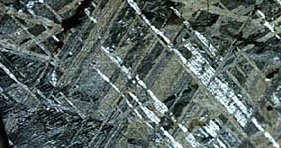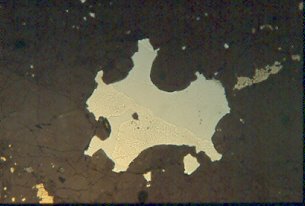
We reproduce the paper published during the 8th Annual Meteoritical Society Meeting, 2005, under the title “the Cooling History of Meteoritic Metal” by J. I. Goldstein, Dept of Mechanical and Industrial Engineering and Dept Geosciences, University of Massachusetts, Amherst, MA 01003, USA. E-mail: jig0@ecs.umass.edu
Instroduction
Metal is present in all types of meteorites and is composed of Fe, Ni and Co, sometimes with additional elements such as P, S, and C. The metal microstructure is often quite complex and may contain kamacite, tetrataenite, a spinodal –cloudy zone, decomposed martensite- plessite, etc. An understanding of the development of the microstructure of meteoritic metal can lead to insights into the cooling history of chondrites, pallasites, mesosiderites, irons, etc. This paper discusses how the presence or absence of P influences the microstructure of metal, outlines recent advances in the development of the metallographic cooling rate method, and indicates new areas whre the study of metal (for example metal in CH chondrites) leads to new insights into the cooling history of meteorites.
Metal Microstructure
Experimentally it has been observed that P is necessary for the formation of the Widmanstatten pattern [1,2]. In binary Fe-Ni alloys, analogous to P free metal in ordinary chondrites, kamacite (α) only forms on grains boudaries during the cooling process [3]. In ordinary chondrites, taenite (γ) grain boundaries formed during metamorphism and are the sites for kamacite formation [4]. Zoneless plessite, for example, contains no exsolved kamacite due to its formation as single crystal taenite at high temperatures [4]. In chondrites, Fe and Ni are mobile on metal –silicate boundaries and on taenite grain boundaries allowing apparently isolated taenite and kamacite grain to remain in contact. The Widmanstatten pattern on the other hand only forms in iron meteorites due to the presence of P and will only nucleate as the meteorite enters the α + γ + Ph (phosphide) phase field in the Fe-Ni-P phase diagram [5]. Nucleation temperatures of around 100 ºC below those given by the Fe-Ni phase diagram are explained by the presence of P. Recent studies of the formation of plessite in meteoritic metal by electron backscatter diffraction (EBSD) techniques [6] have shown that taenite is retained during the cooling process as martensite nucleates and then dissociates at lower temperatures.
Metallographic Cooling Rate Method
Updated diffusion coefficients [7] and nucleation temperatures for the formation of kamacite [5] during cooling have led to more robust and more accurate cooling rate modeling. New cooling rates for the IVA and IIIAB irons have been established using the Wood method [8] showing non-constant cooling rates through these presumed cores of asteroidal bodies.
Summary
The study of meteoritic metal continues to give insight to the cooling history of meteorites and their parent bodies.
References
[1] Goldstein J. I. And Doan A. S. 1972. Geochimica et Cosmochimica Acta 36: 51-69.
[2] Narayan C. and Goldstein J. I. 1985. Geochimica et Cosmochimica Acta 49: 397-410.
[3] Reisener R. J. and Goldstein J. I. 2003a. Meteoritics and Planetary Science 38: 1669-1678.
[4] Reisener R. J. And Goldstein J. I. 2003b. Meteoritics and Planetary Science 38: 1679-1696.
[5] Yang J. and Goldstein J. I. 2005, Meteoritics and Planetary Science 40: 239-253.
[6] Goldstein J. I. and Michael J. R. The formation of plessite in meteorite metal (abstract) Meteoritics and Planetary Science 40.
[7] Yang J. and Goldstein J. I. 2004. Metallurgical and Materials Transactions 35A: 1681-1690.
[8] Wood J. A. 1964. Icarus 3: 429-459.
If you want to find some specific mineral data, chemical formula, molecular weight composition, synonym, density, hardness, magnetism, and the corresponding pronunciation ones, please, take a look at the following mineral web site and choose the Alphabetical Listing:
Small grain of kamacite and tetrataenite. 160X, FOV 0.7 mm, PPL-RL
Smooth appearance of the fusion crust, containing traces of troilite. Kamacite is visible in the granular interior of the stone. 80X, FOV 1.4 mm, PPL-RL.

